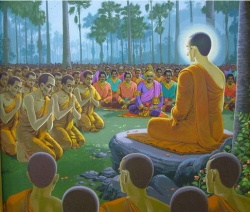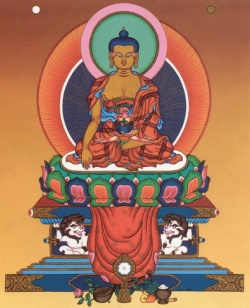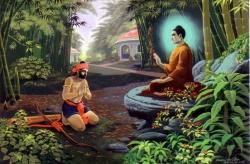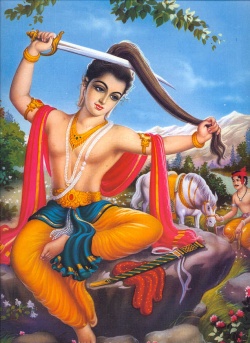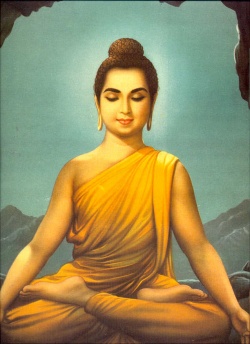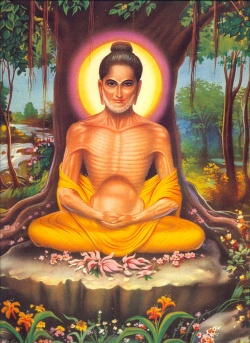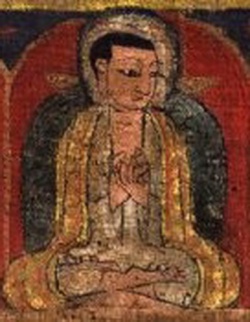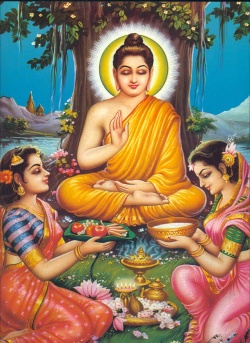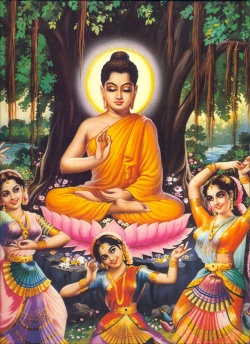Four Noble Truths by Bro. Chan Khoon San
Four Noble Truths
CONTENTS
1. What are The Four Noble Truths?
2. Why are they called Noble Truths?
3. Noble Truth of Suffering
4. Suffering because of The five aggregates of Clinging
5. Noble Truth of the Origin of Suffering
6. Kama-Tanha or Sensual Craving
7. Bhava-Tanha or Craving for Eternal Existence
8. Vibhava-Tanha or Craving for Non-Existence
9. Noble Truth of the Cessation of Suffering
10. References
11. Explanatory Notes
1. What are The Four Noble Truths?
After 6 years of strenuous striving in His last Life, The Buddha finally realized the Truth when He attained Supreme Enlightenment under the Bodhi tree in Bodhgaya, India. This monumental event happened on the full-moon day of Wesak in 588 BC. This topic of the “Four Noble Truths” is the very Heart and core of Buddhism. These Truths, made known by The Buddha after His Enlightenment, constitute the essence of the Dhamma (Teaching), pervading every aspect and every part of it. The Four Noble Truths are:
a) The Noble Truth of Dukkha or Suffering (Dukkha Sacca)
b) The Noble Truth of the Origin of Dukkha (Samudaya Sacca)
c) The Noble Truth of the Cessation of Dukkha (Nirodha Sacca)
d) The Noble Truth of the Path leading to the Cessation of Dukkha
(Magga Sacca)
2. Why are they called Noble Truths?
a) They are truths because they are real and Form an incontrovertible fact of Life. Whether Buddhas arise or not, they exist in the World. It is the Buddhas who reveal them to mankind.
b) They are called Noble (Ariya) because they were discovered by the Greatest Noble Person i.e. one who is utterly remote from all Defilements. Alternatively, they are Noble Truths owing to the establishment of nobleness by the discovery and penetration of them i.e. those who have penetrated The Four Noble Truths are called Ariyas or Noble Ones.
3. Noble Truth of Suffering
a) Birth (Jati) is Suffering
According to Buddhism, the duration of each Phenomenon consists of 3 phases, namely: genesis, static or development, and dissolution. The moment of genesis is birth, the moment of dissolution is Death and the static phase is ageing.
By the birth of a being is meant the genesis of the new Mind and matter after Death upon dissolution of the old existence i.e. the first germ of Life in the new existence. No Suffering or pain as such exists, of course, at the first moment of genesis but since birth serves as the basis for later appearance of physical and Mental Suffering throughout the whole of the ensuing existence, birth is considered as Suffering.
b) Ageing (Jara) is Suffering
Ageing means becoming grey-haired, toothless, wrinkled, bent, deaf and poor in eyesight. In other words, decay has set in, very recognizably, in the Aggregates of Mind and matter of a particular existence. Ageing of the Mind is not so apparent and indications of it such as failing memory and senility become noticeable only when one becomes very old and then only to those close to oneself.
Ageing is concerned with just the static moment of the Aggregates of Mind and matter and has no essence of pain or Suffering in it. But because of ageing, there occurs failing of vitality, impairment of the sense faculties, weakening of health, loss of youth, strength and good looks, people are really afraid of growing old. Since it forms the source of physical and Mental Suffering, ageing is said to be fearful Dukkha.
c) Death (Marana) is Suffering
Death is the extinction of the Life-principle, which has been in
ceaseless operation since the time of birth in a particular existence. All mortals are in Constant fear of Death. But Death is not by itself pain or Suffering as it is the moment of dissolution of the Life- principle of the Aggregates of Mind and matter. However, when Death comes, one has to abandon the physical Body and leave behind one’s family and friends together
with one’s properties. The Thought of leaving the present existence and the uncertainty of the future is very frightening. As Death draws near, all mortal beings are subjected to severe attacks of disease and illness, which rack the Body with unbearable pain. Death, which is the basis for all such physical and Mental agony, has thus been named Dukkha by The Buddha.
d) Sorrow (Soka) is Suffering
Sorrow is the burning in the Mind of one affected by the five kinds of misfortune (byasana), namely: loss of relatives, destruction of property or possessions, deterioration of health and longevity, lapses in Morality and deviation from right view to wrong view.
This sorrow is a Form of Mental displeasure (domanassa) but has inner consuming as its characteristic and as such is intrinsic Suffering, Dukkha-Dukkha. Overwhelming distress occasioned by sorrow can cause heartburn leading to premature ageing and even Death. Being thus a basis for other physical pains too, sorrow is fearsome and is therefore named Dukkha by The Buddha.
e) Lamentation (Parideva) is Suffering
Lamentation is wailing by one affected by loss of relatives, property and any other losses or Suffering. Absent-mindedly and hysterically, the distressed one clamours, proclaiming the virtues of the dead and the quality of the lost property or denouncing the enemy or agency responsible for the loss. In reality, lamentation is merely the material quality of Sound and therefore not Suffering in essence.
But such wailing and hysterical proclamations produce physical discomfort and pain. The Buddha had therefore declared lamentation as Suffering. To cry is to be subjected to pain which is therefore Suffering.
f) Physical pain (Dukkha) is Suffering
Bodily pains such as stiffness, aches, soreness, tiredness, itchiness, and Feeling hot or cold are Suffering. These physical pains are true intrinsic Suffering called Dukkha-Dukkha. Even Animals flee to safety at the slightest hint of getting beaten or
shot at because they are afraid of physical pain. It is important to know that sickness and disease come under this category of physical pain. Physical pain is generally followed by Mental distress and for thus serving as a cause for Mental pain it is named Dukkha, dreadful Suffering.
g) Mental displeasure (Domanassa) is Suffering
The Pali word “domanassa” means bad-mindedness or Mental pain.
It denotes all sorts of Mental aversion or displeasure such as worry, anxiety, depression, dislike, hate, fear, misery, etc. Mental displeasure also is intrinsic Suffering that not only oppresses the Mind but also tortures the Body such as causing stress, insomnia, and loss of appetite with consequent impairment of health and even the advent of Death. It is a truly formidable Dukkha.
h) Despair (Upayasa) is Suffering
Despair is ill-Humour or dejection produced by excessive Mental agony in one affected by loss of loved ones, property and any other losses or Suffering. It causes repeated bemoaning over the loss resulting in burning of the Mind and physical distress and can even lead to Insanity or suicide. Despair is therefore Suffering because of the intense burning of the Mind and physical pain accompanying it. People, accordingly recognize the state of despair as a fearsome Dukkha.
As an illustration, sorrow (soka) is like cooking of oil or dye- solution in a pot over a slow Fire. Lamentation (parideva) is like its boiling over when cooking over a quick Fire. Despair (upayasa) is like what remains in the pot after it has boiled over and being unable to do so any more, goes on cooking in the pot till it dries up.
i) Association with the hateful is Suffering
Association with the hateful is meeting with disagreeable beings or undesirable objects. Such meeting is not itself unbearable pain but in such situations, reaction sets in at once in the Form of Mental disturbance and physical discomposure. As it serves as a cause of Mental and physical distress, The Buddha designated it as Dukkha,
dreadful Suffering.
j) Separation from the beloved is Suffering
Separation from the beloved is not itself a painful Feeling. However when separation takes place, by Death or while still alive, from
beloved ones or when parted from one’s treasured possessions, Mental agony sets in at once. As it promotes various Mental Afflictions, The Buddha had called the separation from the loved ones and desirable objects, Dukkha, dreadful Suffering.
k) Not getting what one desires is Suffering
Not getting what one desires is not itself a painful Feeling. But the unfulfilled desire often results in great disappointment, despair, and may even lead to suicide. Suffering also arises out of desire for some unobtainable object such as the desire to be free from Suffering.
Without practising and developing the Noble Eightfold Path, freedom from Suffering is unobtainable by mere wishing and not getting what one wants causes Mental anguish. Here the object of one’s desire also includes the worldly gains and Wealth that cannot be attained by mere desiring. Not getting them as one desires is also Dukkha.
l) In short, The five aggregates of Clinging are Suffering
A sentient being is made up of The five aggregates or Groups that Form the objects of clinging or grasping. The five aggregates of Clinging or Grasping (Upadana-khanda) are:
i) The Aggregate of matter or material forms (Rupa-khanda)
ii) The Aggregate of Feeling (Vedana-khanda)
iii) The Aggregate of Perception (Sanna-khanda)
iv) The Aggregate of volitional activities (Sankhara-khanda)
v) The Aggregate of Consciousness (Vinnana-khanda)
All Sentient beings exist as such only with these five Aggregates forming their substantive mass. They cling to their Body, which is merely an Aggregate of material forms, regarding it as “I, my Body, permanent, etc.” Hence the group of material forms is called an Aggregate of clinging. The Mental groups made up of Feeling, Perception, Mental activities and Consciousness are also grasped at, taking them to be “I, my Mind, it is I who thinks, permanent, etc.” Hence they are also called Aggregates of clinging.
The five aggregates of Clinging at the moment of seeing
i) The eye and the visible object are the Material Aggregate.
ii) Feeling pleasant, unpleasant or neutral is the Feeling Aggregate. iii) Recognizing or remembering the object is the Perception Aggregate.
iv) To will to see and turning the attention on the object is the
Volitional Activities Aggregate.
v) Just knowing that an object is seen is the Consciousness
Aggregate.
4. Suffering because of The five aggregates of Clinging
a) Dukkha-Dukkha or Intrinsic Suffering
The eleven types of Suffering, starting from the Suffering of birth to the Suffering of not getting what one wants, are all obvious types of Suffering known as Dukkha-Dukkha or intrinsic Suffering. They arise only because there are the 5 Aggregates of clinging; without them, such Suffering will not arise.
In short, because there is Body or the material Aggregate, physical and Mental sufferings dependent on the Body arise. Because there are Feeling, Perception, volitional activities and Consciousness Aggregates, physical and Mental sufferings based on them also arise. Thus the 5 Aggregates of Clinging are Dukkha-Dukkha, intrinsic Suffering. Cases of Dukkha not so obvious that occur as a result of the operation of the Law of Change are called viparinama Dukkha, Suffering due to change.
b) Viparinama Dukkha or Suffering due to change
Pleasurable physical sensations arising from agreeable tactile impressions (touch) are called pleasant bodily feelings. Joyful states
of Mind arising from reviewing pleasurable sense objects are called pleasant Mental feelings. These 2 forms of happy states please all beings. All beings go after these states all the time, even at the risk of their lives and when these are attained, their Happiness knows no bound.
However, while they are rejoicing with blissful Contentment, if the sense objects that have given them so much Happiness and delight disappear or get destroyed, great would be their agitation followed by agony. When the Wealth which they have accumulated in the Form of money or property suddenly get lost through one reason or another; when Death or separation comes to their loved ones;
intense Grief and distress ensue, which can even cause derangement. Thus, these 2 forms of Happiness namely pleasant physical and Mental feelings are also a type of Suffering because of change. Because they arise dependent on the five Aggregates, the five Aggregates of Clinging are viparinama Dukkha, Suffering due to change.
c) Sankhara Dukkha or Suffering due to conditioning
The word Sankhara in “Sabbe Sankhara Dukkha or all conditioned things are Suffering” here means conditioned things or resultants of determining conditions. It has a different meaning from the Sankhara in “sankharakkhanda” which means volitional activities.
The five aggregates of Clinging are always in a state of flux, Impermanent and none of them are self-existing. They arise out of various causes. They are conditioned. Their existence depends on certain conditions and when these conditions and causes cease to exist, they too cease to exist. As Death awaits constantly, having to rely on the Impermanent Aggregates of clinging for physical substance or support is dreadful, like living in a building which shows signs of collapsing any moment.
The transitory nature of The five aggregates of Clinging require Constant effort at conditioning for the maintenance of the status quo, e.g., the Body needs Constant feeding in order to survive, feelings of Happiness require Constant contact with agreeable sense objects. Even the everyday medial neutral feelings need effort at conditioning, e.g., without adequate rain, there is a
shortage of water and everyone suffers the effect of the drought. This implies laborious effort, which of course is Dukkha. Therefore, The five aggregates of Clinging are Sankhara Dukkha, Suffering due to conditioning.
SUMMARY
The five aggregates of Clinging are intrinsic Suffering, Suffering due to change and Suffering due to conditioning. In short, The five aggregates of Clinging are the Noble Truth of Suffering.
5. Noble Truth of the Origin of Suffering
According to The Buddha, the Noble Truth of the Origin of Suffering is “Tanha” or Craving which leads from birth to birth, which accompanied by pleasure and Greed, finds ever fresh delight now here, now there, everywhere. What is this “Tanha” or Craving? It is of three kinds:
• Kama-Tanha, the sensual Craving, the desire for enjoyment of sensuous pleasures.
• Bhava-Tanha, Craving for eternal existence, holding the eternity-belief.
• Vibhava-Tanha, Craving for non-existence (self-annihilation), believing that there is nothing after Death.
Where does this Tanha, Craving arise and take root?
“Wherever in the World, there are delightful and pleasurable things, there this Tanha, Craving arises and takes root.”
What are the delightful and pleasurable things in this World?
They may be summarized as the following:
• The six sense bases: eye, ear, nose, tongue, Body and Mind.
• The six sense objects: visible object, Sound, smell, taste, touch and Mind objects.
• The six types of Consciousness viz. seeing, hearing, smelling, tasting, touching and Thinking Consciousness.
• The six types of sense impressions or contacts.
• The six types of Feeling (Vedana), Perception (sanna), volition (cetana), Craving (Tanha), initial application (Vitakka) and sustained application (Vicara) arising from six types of contact.
Each of the above objects is attractive and pleasurable. This Craving arises and takes root in whatever is delightful, attractive and pleasurable. This is called the Noble Truth of the Origin of Suffering.
6. Kama-Tanha or Sensual Craving
Sensual Craving is Craving for pleasurable sense objects whether belonging to one’s own person or to other persons. They include:
i) Beautiful sight and visible objects such as appearance, Form or
Body.
ii) Pleasing Sound and Sound objects such as voices and persons making the Sound.
iii) Delightful smell and its source such as perfume and persons using it.
iv) Delicious taste and the Food producing the taste, men and women who prepare and serve the delicious Food.
v) Tactile sensations of rapture and objects producing such sensations
vi) Wishing to be born as a Deva, a man, a woman, longing to enjoy the sensual pleasures as a Deva or as a human being. Taking
delight in such pleasurable thoughts is also sensual Craving.
Because of Ignorance (Avijja) or “not knowing things as they truly are,” one holds the erroneous Perception, Thought and view called Illusion of Perception (sanna-vipallasa), Illusion of Thought (Citta- vipallasa) and Illusion of View (Ditthi-vipallasa) by considering:
• The Impermanent as permanent
• Suffering as Happiness
• Non-self as self
• The loathsome as beautiful
Thus Thinking what is unpleasant to be pleasant, liking is developed for it. Liking it and desiring it leads to Craving which drives one into activities in order to fulfill the Craving. Such activities are the Kamma (causes) and Sankhara (volitional activities) responsible for the formation of new Aggregates of Mind and matter in the new existence. Influenced by Craving,
even the Death Consciousness clings tenaciously to objects seen at Death’s door, and after it vanishes, the Rebirth Consciousness arises holding on to the last seen objects to give rise to a new being consisting of the 5 Aggregates of Clinging which are Suffering. Thus Kama-Tanha, sensual Craving, is the Truth of the Origin of Suffering.
7. Bhava-Tanha or Craving for Eternal Existence
This is the Craving based on the belief in the permanence or stability of existence. It is the Craving accompanied by the wrong view that the soul or living entity does not perish even when the physical Body dissolves away. It enters into a new Body and remains there. Even if the World crumbles and breaks up, it remains eternal and never perishes.
Religions outside the Teaching of The Buddha mostly hold this view of eternalism. Some believe that when a person dies, he remains permanently in Heaven or suffers eternal damnation in Hell according to the God’s wish. Others believe that a being transmigrates from one existence to another according to Kamma and exists permanently. For instance, a bird on a tree flies to
another tree when the first tree falls down. When the second tree falls down again, it flies to a third tree. Likewise, the soul or living entity, on dissolution of a gross Body or Form on which it is dependent, moves on to another coarse Body, itself remaining everlasting, undestroyed.
Bhava-Tanha, Craving for eternal existence takes delight in the view that the soul or living entity is permanent and enduring. This “I” which has been in permanent existence since eternity feels the sensations and will go on Feeling them. Believing thus, it takes delight in every object experienced by the 6 senses and also in objects one hopes to come to enjoy in the future. So it wishes to
enjoy a prosperous Life now and in future; to be born in good happy existences; to enjoy the good Life of human or celestial being. Some wish to be born always a man, some a woman. All these wishes are Craving for existence. Because of this Craving, a conditioning influence or potential Power is built up for the arising of a new Life consisting of The five aggregates of Clinging that are Suffering. Thus Bhava-Tanha, Craving for eternal existence, is the Noble Truth of the Origin of Suffering.
8. Vibhava-Tanha or Craving for non-existence
This is the Craving based on the belief that there is existence only while alive, there is nothing after Death. It is the Craving which is accompanied by the wrong view of non-existence which holds that nothing remains after Death; there is complete annihilation. This Craving likes the idea that after Death, existence is annihilated without any special effort. The reason
is that one who holds this view shrinks from the practice of meritorious deeds and does not abstain from Evil deeds. The Evil deeds committed are also numerous. If new Life occurs after Death, these Evil deeds will bear unwholesome effects that they cannot relish. Only if nothing happens after Death and there is no new existence will their misdeeds be without effect and they can escape scot-free from all consequences of their Evil actions. Hence this great appeal of the nihilistic view.
At the same time, holding that the time for enjoying is now, the present Life before Death, they are too eager to go after any desirable object of pleasure. Hence they go all out in pursuit of their pleasure without Thinking of the consequences. Such ardent pursuit of sensual pleasures leads to commission of Kamma (causes) and Sankhara (volitional activities) every act of which
constitutes to formation of new Life. Each time there is delight in, and enjoyment of pleasures of the present Life, the sensual Craving is imparted to the Consciousness. Even at Death, it clings to the objects seen at Death’s door, and after it
vanishes, the Rebirth Consciousness arises holding on to the last seen objects to give rise to a new birth of The five aggregates of Clinging, which are Suffering. Thus Vibhava- Tanha, Craving for non-existence, is the Noble Truth of the Origin of Suffering.
SUMMARY
The true cause of Suffering lies in the three cravings namely: Craving for sensual pleasure, Craving for eternal existence, and Craving for non-existence.
9. Noble Truth of the Cessation of Suffering
According to The Buddha who had completely realized the Noble Truth of the Cessation of Suffering; it is the complete fading away and extinction of this Craving; its forsaking and giving up; the Liberation and detachment from it. The Truth of the cessation of Suffering is then the extinction of its origin, Craving. In Buddhism, there are 4 stages in the extinction of Craving.
a) First Stage of Sainthood
One who has realized the First Stage of Sainthood is called a
Sotapanna or stream-winner because he has entered the stream that leads to Nibbana. The stream represents the Noble Eightfold Path. A
Sotapanna has unshakeable Faith in the Buddha, Dhamma and Sangha. He neither violates the 5 precepts or commits the heinous crimes (see Chapter V, Part 8 b). He has also destroyed self-Illusion (sakkaya Ditthi), doubts (vicikiccha) and false practices (silabbata paramasa) that do not lead to the end of Suffering. As he has not eradicated all the Fetters that bind him to
existence, he will suffer not more than seven rebirths in the sense sphere. For the Sotapanna, the doors of the woeful states are closed forever and he will never revert to a World-ling again. He will eventually attain Arahantship and enter Nibbana.
There are three types of sotapannas, depending on the number of rebirths before they attain Arahantship and enter Nibbana namely:
• Ekabiji-Sotapanna = enters Nibbana after one Life.
• Kolamkola-Sotapanna = enters Nibbana after two to six lives.
• Sattakkhattu-parama-Sotapanna = enters Nibbana after seven lives.
b) Second Stage of Sainthood
One who has realized the Second Stage of Sainthood is called a sakadagamin, which literally means ‘once returner’. The Second Sainthood Knowledge further weakens the grosser forms of sensual Craving and ill-will to the extent that he will suffer not more than one Rebirth in the sensual plane before he attains Arahantship. Compared to the Sotapanna, the sakadagamin has less Greed or lust (Raga), ill-will (dosa) and Delusion (Moha). Thus he is nobler than the Sotapanna.
c) Third Stage of Sainthood
One who has realized the Third Stage of Sainthood is called an anagamin. Since this stage of sainthood destroys the Fetters of ill- will and sensual Craving, an anagamin will no longer experience Anger, hatred, worry, despair, fear, and any other unpleasant Mental Feeling; neither will he crave and enjoy sense pleasures. However, the subtle forms of Craving (such as existence in the
fine material plane) and Ignorance are still dormant. Thereafter, he is not reborn in the sensual plane but in the Pure Abodes where he attains the Final Stage of Sainthood and lives till the end of his Life. 'Anagamin' literally means 'Non-returner', one who will not be reborn in the sensual realms.
d) Final Stage of Sainthood
One who has realized the Final Stage of Sainthood is called an Arahant. An Arahant has completely destroyed all forms of Craving and eradicated all the Samyojanas or Fetters (Note 1) that bind one to existence. As his Mind is always free from all Defilements, it is at the purest state, making him the noblest one. He is a true Saint, worthy of respect by men and devas and worthy of receiving alms which are offered to him with the intention of enjoying the benefits in the present Life as well as in future lives.
An Arahant, literally meaning a Worthy One, does not accumulate fresh Kamma and he is not subject to Rebirth because the conditions for his Rebirth have been destroyed. The Arahant understands:
“Birth is exhausted, the Holy Life has been lived out, what was to be done is done, there is no more of this to come”.
The Arahant has completely realized Nibbana, the Noble Truth of the Cessation of Suffering.
10. References
1) Dhammacakkappavattana Sutta (The Great Discourse on the Wheel of Dhamma) by the Venerable Mahasi Sayadaw of Burma.
2) The Four Noble Truths (Sacca Vibhanga), Abhidhamma Pitaka
– Vibhanga. The Five Nikayas – An Anthology. Translated by the Editors of the Light of the Dhamma, Department of
Religious Affairs, Rangoon, Burma 1977.
11. Explanatory Notes
Note 1: Samyojana means Fetter that binds beings to the Wheel of existence and to the rounds of misery. There are ten Fetters, namely:
i) Sakkayaditthi = false view of a personality taking the complex combination of psycho-physical Aggregates as a person or self or I.
ii) Vicikiccha = skeptical Doubt about The Buddha, Dhamma, Sangha, the Training, past lives, future lives, both the past and future lives, and Dependent origination.
iii) Silabatta-paramasa = adherence to the false view that one becomes pure and thus be liberated by bovine and canine Morality or by rites and Rituals.
iv) Kamaraga = Attachment to sensuous objects, namely visible object, Sound, odours, taste, tangible object, Mind object.
v) Patigha = ill-will, Anger, aversion.
vi) Mana = conceit or pride.
vii) Uddhacca = restlessness.
viii) Ruparaga = Attachment to the rupa-jhanas (the Form absorptions) and
rupa-existence (existence in the Form realms).
ix) Aruparaga = Attachment to the Arupa-jhanas (formless absorptions)
and Arupa-existence (existence in the formless realms).
x) Avijja = Ignorance (see Chapter IV, Part 5.XI for a full definition).
Fetters Nos. i, ii, iii are eliminated at the First Stage of Sainthood (Sotapanna), Nos. iv, v are only weakened at the 2nd Stage (Sakadagamin) but eliminated at the 3rd Stage (Anagamin) while the remaining Fetters are all eliminated at the 4th Stage of Sainthood (Arahant).
